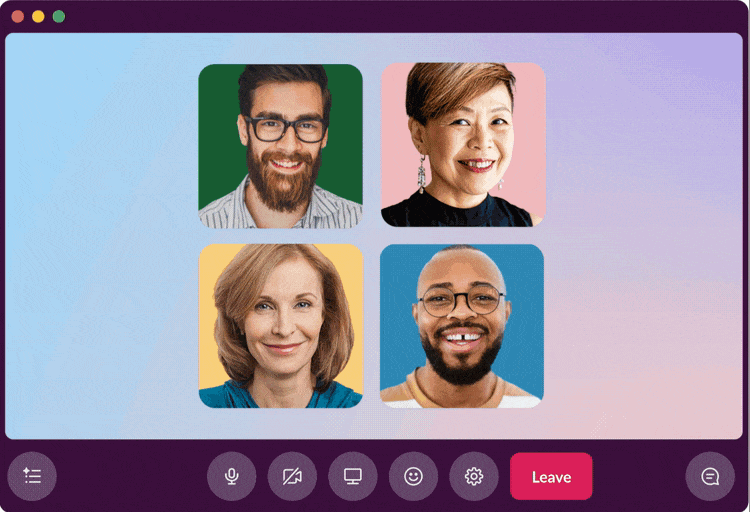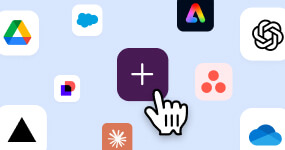Think about how much information you deal with in a typical workday. Most teams today struggle with information overload, whether they’re in an office or another work setting. It’s easy to miss critical details buried in long message threads, documents, or meetings.
That’s where AI summarization tools can make a real difference. Often called recap generators or text summarization tools, they’re designed to take complex or large amounts of information and break it down into concise summaries that highlight the most important points. This not only saves time but also helps teams process information more efficiently and make smarter decisions faster.
In this AI summarization guide, learn how these tools work, when to use them, and the features that provide the most benefits.
What is AI summarization?
AI summarization tools use artificial intelligence technologies to condense large amounts of data — including text, audio, and video — into smaller, more digestible formats that retain key points. They analyze documents and other media for phrases or concepts discussed most often or given the most attention, then use natural language to restate that information in simple terms.
The two main types of AI summarization are extractive and abstractive.
- Extractive summarization uses AI to extract key sentences or phrases from the source material to create a summary. Think of it like a friend listing the highlights of a movie so you know all the key plot points.
- Abstractive summarization uses AI to generate new sentences from the source material to create a recap. In this case, your friend would be using their own words to summarize a movie for you.
For example, an extractive AI summary of long meeting notes would pull out exact quotes from the meeting’s speakers, while an abstractive summary would describe a few key takeaways in uniquely generated natural language.
Extractive summaries prove most useful for things like summarizing meeting notes (with speaker attributions) and finding key quotes from a research paper, while abstractive summaries help distill main points from long emails or chat threads.
How does AI summarization work?
AI and machine learning (ML) technologies are the driving force behind summarization tools. They rapidly analyze data while keeping the original context intact. Here’s a quick look at how an AI summarization tool typically works:
- Process. The AI absorbs content by scanning text, watching videos, or listening to audio to understand its meaning.
- Identify. It pinpoints relevant phrases, action items, and key moments by looking at headings, keywords, or visuals.
- Create. It then generates a condensed version of the content, highlighting the key information it identified while preserving the meaning of the original material.
What are the benefits of AI summarization?
AI summarization tools help you find quick answers, save time, and stay in the moment. Some of the benefits of AI summarization are:
- Saving time. AI summarization tools process and act on information quickly when speed matters most — like reviewing documents between meetings or when catching up on missed messages.
- Reducing information overload. AI summaries allow you to process the key information that matters, skipping over greetings and small talk. This frees up mental energy for more important work.
- Improving decision-making. Not only do summaries help you make decisions faster, but they also improve decision quality by focusing your attention on the most relevant information.
- Streamlining collaboration. When everyone has the most important information at their fingertips, it reduces miscommunication and keeps goals aligned.
- Retaining knowledge. Clear, digestible summaries are easier for team members to remember and apply to their work.
- Integrating support. Some work operating systems include AI agents that produce summaries of all the apps where work happens. For example, Slack’s AI agents can summarize any channel, huddle, or other workspace connected to Slack.
These benefits make it clear that AI summarization and workflow automation tools aren’t just productivity hacks — they enhance operational efficiency, streamline collaboration, and ultimately drive growth.
Key use cases for AI summarization
To truly work smarter and faster with AI summaries, everyone in your organization needs to be on board. Whether you use a work operating system like Slack with built-in AI features or an integrated solution, everyone on your team should look for ways to use AI and automation in their daily workflows for increased efficiency.
Here are a few instances where AI summarization can help teams save time:
- Meetings. Stay engaged with your team during calls while your AI summarization tool takes notes. It can capture who said what, recap key points, and add action items to your task list.
- Onboarding. Get new hires up to speed on project, department, or organization details by condensing relevant information into a digestible format they can use immediately.
- Daily recaps. See what you missed while you were away from your desk. AI can summarize important messages from your Slack channels or direct messages.
- Surface information. Quickly gain context about an issue without manually sifting through dozens of conversations and files. AI can surface information to find the answers you need.
- Email summarization. Get to the heart of lengthy email chains in seconds by using an AI-based email app integration to pull the key points from long conversations.
- Research documents. When you don’t have time to read a multipage report, let an AI summary condense the most essential information.
 When you’re in a Slack huddle with your teammates, an AI agent can take notes for you, recap key points, and even assign tasks.
When you’re in a Slack huddle with your teammates, an AI agent can take notes for you, recap key points, and even assign tasks.
The future of AI summarization
The adoption rates for generative AI tools are increasing rapidly, with more businesses recognizing their benefits.
Salesforce’s State of Sales report found that 81 percent of sales teams are investing in AI, with 41 percent having fully implemented solutions at their organization. Researchers at Project on Workforce “estimate that between 0.5 percent and 3.5 percent of all work hours in the U.S. are currently supported by generative AI.” And a survey of global desk workers by Workforce Lab at Slack revealed that AI use has increased by 60 percent since September 2023. While consumer tools garnered attention in the early days of generative AI, EMARKETER reported workplace adoption “will drive nearly half of its use by 2026.”
But even as demand for generative AI increases, there are still challenges with the technology. For example, general AI summarization tools don’t always grasp the full context of lengthy conversations or industry-specific terms. And tools that source the internet for information, in addition to just your data, can sometimes produce hallucinations, or false truths. Leaders need systems with clear data policies and integration across apps to mitigate some of these issues.
Here are a few things on the horizon for gen AI:
- Multimodal technologies (audio, image, text, and video) can offer flexibility while improving output quality. Imagine using AI to summarize action items from a meeting based on visuals and spoken words. Gartner predicted that “40 percent of generative AI solutions will be multimodal by 2027, up from 1 percent in 2023.”
- Company control over data can enhance security. Organizations can use AI in Slack to control what information large language models (LLM) can access based on a user’s permission level. Teams get relevant results based on their roles, while businesses maintain data privacy standards.
- Domain-specific gen AI can improve accuracy and reliability. According to Gartner, models trained for specific business functions, sectors, or tasks using controlled data sets have the most potential to reach the mainstream within 10 years.
- Integrated gen AI tools will enable workflows across connected apps, like GitHub and Jira. Incorporating data from shared tools can enrich summaries and enhance productivity.
Key features to look for in an AI summarization tool
An AI-powered text summarizing tool should make work easier for your teams, not add new headaches. Look for a conversational platform that brings core tasks and people together to improve comprehension, collaboration, and productivity.
AI summarization features to look for include:
- Flexible capabilities. Teams communicate through video, text, and audio, so it’s important to choose an AI summarization tool that can process multiple formats. In our guide to AI in Slack, we show how built-in features help people find information faster across threads, channels, and direct messages.
- Real-time note taking. Immediate access to concise summaries and key points can improve results, whether you’re joining a meeting late or making on-the-spot decisions. Use Slack AI to take notes during a huddle, capture key takeaways, and list action items. This keeps meetings on track and ensures everyone is on the same page.
- Source material citations. Verifying accuracy is a top priority when using AI tools, so choose a solution that provides sources for information. For example, when you ask Slack AI a question, the answer comes with citations that refer to the source messages or files that informed them. You can hover over the citation to preview the source or click to view it.
- Simple interface. Make sure your tool is user-friendly and easy to learn so anyone on your team can start using it right away. For example, Slack lets users initiate huddle notes and view channel summaries by clicking on an icon within the platform.
- App integrations. Improve adoption rates by choosing a solution that connects to the apps you use daily. With Slack as your central work operating system, you can apply AI summarization to third-party apps to enhance your workflow.
- Collaboration tools. Encourage teamwork by ensuring your summarization app allows for sharing and collaboration. When you use AI notes, Slack organizes the information into a canvas and shares it with the huddle thread.
- Security and privacy. Many generative AI tools have poor or non-existent data security policies. To keep your organization’s data safe, vet each tool you consider using for enterprise-grade security certifications awarded by trusted organizations.
- Multilanguage support. If the AI summarization tool you use can only respond in English, you’ll narrow the pool of people who benefit from it, especially if you’re part of an international organization. Make sure your AI works in every language your colleagues speak.
Best practices: Work smarter and faster with AI summarization tools
AI summarization tools make it easier for teams to communicate and collaborate, surfacing information quickly to enhance daily workflows. They let you catch up on missed work chats, quickly review meeting notes, summarize entire channel conversations, and find answers in one place.
To get the most out of an AI summarization tool, approach it with a clear vision of what the technology can do for you. Be creative in finding ways AI saves time and energy, but avoid forcing AI into workflows where it doesn’t fit. If you train your team to use AI frequently, they’ll be able to discover the best uses.
It’s also important to remain realistic about AI’s capabilities. AI summaries can hallucinate, so encourage team members to review and validate summaries before distributing them to colleagues. Remind everyone to use AI to supplement existing context and to reference original documents to confirm assumptions or answer questions.
Finally, keep in mind technical concerns. First, guarantee the tool you use employs strict data security policies. Second, think about how it integrates with your existing apps and workflows. You want a tool that works seamlessly with the software your team uses to create documents, hold meetings, and communicate with each other.
AI summarization tools offer the most benefits when you use them intelligently. If you understand AI summarization’s strengths and weaknesses, your team can deploy it exactly where it benefits them the most, becoming more informed, efficient, and productive as a result.
AI Summarization FAQs






